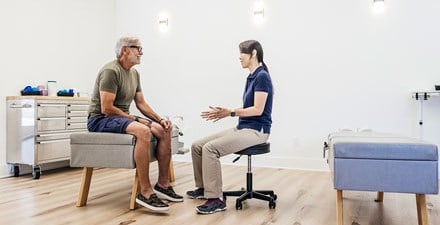
Overtraining is a concern for all people pursuing fitness — from recreational or elite athletes to people who exercise to lose weight and stay in shape.
Overtraining injuries are musculoskeletal (involving muscles, joints, and bones) injuries that occur due to more activity or exercise than your body is used to. They can happen to anyone who increases the amount or intensity of activity or changes the type of activity.
Overtraining syndrome includes overtraining injuries, but also encompasses general fatigue and other symptoms.
Signs and Symptoms
If you experience any of the following after working hard to meet advanced fitness goals, overtraining may be a cause.
- Physiological: increased resting heart rate, increased blood pressure.
- Physical: decreased appetite, upset stomach, insatiable thirst, sleep disturbances, increased frequency of sickness and infections, general feeling of increased difficulty and fatigue throughout the day, abnormal muscle soreness, pain occurs that is different than typical muscle soreness.
- Behavioral: personality changes, decreased motivation, altered concentration, lowered self-esteem, decreased ability to cope with stress.
- Performance: increased heart rate during activity, decreased strength or endurance, impaired movement and coordination, multiple technical errors.
Avoiding Overtraining Injuries
No matter the activity (running, swimming, weight lifting, or others), when working to improve your fitness you need to push yourself in order to see results. But pushing yourself too hard can result in injuries that are detrimental to your fitness goals.
Here are some tips to avoid overtraining injuries:
Don't increase exercise difficulty level too quickly. Exercise needs to be progressed steadily at a gradual pace. Following a structured plan that increases your activity incrementally and safely can help you stay healthy and pain free. For example:
- For running, increasing difficulty may include increasing speed, running up or downhill, increasing duration, and use of intervals, where you alternate intensity over time.
- For resistance training, increasing difficulty may include increased weight, repetitions, sets, and decreasing the amount of time to perform the same amount of exercise.
Pay attention to your body. Your body is smart. If it feels like you are developing signs of overtraining, then take a break, lessen your activity, or rest.
Ease into it. Particularly if you are new to fitness or altering your exercise activities, take it slow. Don't expect to make up for several months of inactivity with a few weeks of exercise. Aim for long-term consistency, not overnight success. People who try to do too much too soon often end up injured or frustrated and give up on their fitness goals altogether.
Avoiding Overtraining Syndrome
Overtraining syndrome occurs when an active individual or athlete increases activity faster than the body can adapt or is unable to recover from a sustained high level of activity. Your body then lets you know that you've done too much too fast through a variety of physical responses.
There are several signs and symptoms that may indicate overtraining syndrome but are also symptoms of other problems
Every active individual is unique. Your pain may be due to overtraining, but it also may be due to other health issues. For example, heart rate changes, general fatigue, and other systemic symptoms may be due to a more concerning condition. Physical therapists are educated to evaluate and treat a variety of conditions. If you have any of the above signs a physical therapist can help to determine the seriousness of the signs and what your next course of action for your health.
Here are some tips to avoid overtraining syndrome:
Take a break. If you have a scheduled rest day in your plan, use it, you've earned it! Your bones, joints, and muscles need rest days to stay healthy.
Get rest. Recent studies are supporting the important role of sleep in the health of active people and athletes. This is when our bodies' build and repair and our immune system recovers.
Eat well. Proper nutrition is essential to the health of your body. Do not severely restrict calories when exercising. Make sure to eat proper nutrients, including plenty of lean meats, fruits and vegetables.
How Can a Physical Therapist Help You Meet Your Fitness Goals?
Physical therapists are movement experts, and work with people of all ages and levels of activity. During a visit, a physical therapist can:
- Check your flexibility, strength, and endurance of muscles to support your desired level of activity.
- Ensure that symptoms are due to overuse or overtraining and not something more serious.
- Identify training errors to ensure a safe fitness plan, no matter your previous level of activity.
- Correct biomechanical problems in form with your chosen activity to avoid overuse of a susceptible body part.
- Provide appropriate training plan to minimize risk of injury and help you safely meet your fitness goals.
You can contact a physical therapist directly for an evaluation. To find a physical therapist in your area, visit Find a PT.


